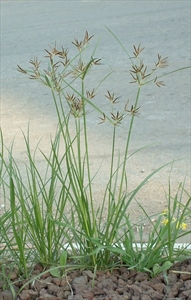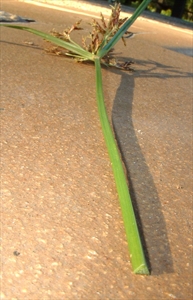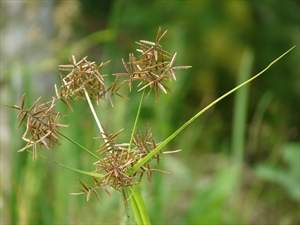Nutgrass; CABI prefers the name purple nutsedge.
Pacific Pests, Pathogens and Weeds - Online edition
Pacific Pests, Pathogens & Weeds
Nutgrass (453)
Cyperus rotundus. It is a member of the Cyperaceae.
Asia, Africa, North, South and Central America, the Caribbean, Europe, Oceania. It is recorded from Australia, American Samoa, Cook Islands, Federated States of Micronesia, Fiji, French Polynesia, Guam, Kiribati, Marshall Islands, Nauru, New Caledonia, New Zealand, Niue, Northern Mariana Islands, Palau, Papua New Guinea, Samoa, Solomon Islands, Tonga, Vanuatu, and Wallis & Futuna.
There are various thoughts on the origin of this sedge. Parts of Asia, Africa and even Australia have been suggested.
Nutgrass is considered one of the world's worse weeds: it is recorded from many tropical and sub-tropical countries, infests large numbers of crops, and grows in a wide variety of environments, irrespective of soil types. It is particularly problematic in field crops, orchards, vineyards, pastures, gardens, fallows, natural and waste areas, footpaths, roadsides, and banks of waterways, where it grows rapidly, produces underground tubers that can regenerate plants, and is tolerant of many herbicides, making it very difficult to control.
Nutgrass is a perennial sedge, 20-60 cm tall (Photo 1). Leaves are glossy, narrow, 7.5-20 cm long and 2-6 mm wide, at the base of the stems (Photos 1&2). A network of creeping underground stems (rhizomes) produces small, 10-25 mm long, tubers in chains, white and fleshy at first, later brown and wiry; and buds on the tubers give rise to new plants (Photo 2). The upright flower stems are smooth, glossy and triangular in cross-section (Photo 3). They have 3-8 branches of different lengths (up to 10 cm long), with leaf-like structures beneath (bracts); each branch has several reddish-brown flower spikelets (10-25 mm long and 2-2.5 mm wide) (Photo 4). The fruits are 3-angled, 1.5 mm long, brown or black. Inside there is a single seed. Usually these fruits do not mature, so seed germination is very low (1-5%).
Spread over short distances is by growth of underground stems, spreading to form large colonies. The tubers are also spread during cultivation and in soil on machinery. Long-distance spread is by human activity: fruits (seeds are inside), rhizomes and tubers contaminate soil. Tubers can be carried by flood waters. Intentionally spread as a food and animal feed.
Nutgrass is a weed of major economic important infesting many crops, and also an environmental weed through its ability to invade native vegetation. Dense infestations of more than 5000 shoots per m2 are possible, smothering other plants and taking nutrients and water from the soil. In Pacific island countries, it is a serious weed of root crops, banana plantations and vegetables. Reductions of between 10-90% are possible depending on the level of infestation and the crop. Vegetable crops are particularly impacted by nutgrass, but there is also damage to root crops, e.g., by nutgrass stems piercing underground storage organs.
Preparations are used in traditional medicines, perfumes and spices in Asia and Africa. The tubers are bitter but are used as a famine food. Used (in Spain), roasted or as a milk in speciality foods.
BIOSECURITY
There is a high risk of introducing this weed. Countries not yet infested should consider all likely pathways for entry, and apply quarantine measures accordingly. Consideration should be given to movement of tubers as a speciality food, and associated with animal feeds.
It is considered one of the worst 10 weeds in Fiji, French Polynesia, Guam, New Caledonia, Papua New Guinea, Solomon Islands and Tonga.
Cyperus rotundus is on the Global Invasive Species Database (2020) of information about alien and invasive species that negatively impact biodiversity, managed by the Invasive Species Specialist Group of the IUCN Species Survival Commission.
BIOCONTROL
Attempts with several moth species have been tried, with Bactra species the most promising, but the limited results is possibly because they have been attacked by local parasites. The mycoherbicide, Dactylaria higginsii, is a biological control fungus against purple nutsedge.
CULTURAL CONTROL
- Physical & Mechanical:
- Hand-weeding; it is not only expensive, but also likely to break the chains of tubers and encourage them to grow.
- Shade with taller plants; this is effective, limiting top growth, but it forces the tubers into dormancy, and as soon as the shade is removed they grow and re-establish the weed once more.
- Plough and disc the land; to be effective, this has to be done every 2-3 weeks, so it is expensive. In general, tillage of the soil results in some control as it desiccates the tubers, but usually there are many remaining in the ground. Cultivation frees the tubers from each other, and this stimulates them to break dormancy, spreading the plant. It is probably best to combine tillage with herbicide applications (see below).
- Use polyethylene mulch; while it can be effective, the initial cost, the cost of laying, collecting after harvest, and disposal, are high, and suitable only for high-value crops. Note, nutgrass is capable of piercing plastic. Seek expert advice on the type of plastic mulch (clear or black) to use in your area.
- Hygiene:
- Clean (wash-down) all machinery used on infested fields before entering those yet free from nutgrass. Wash to remove soil and tubers.
- Livestock:
- Use ducks and chickens at high densities.
CHEMICAL CONTROL
In Australia: glyphosate; 2,4-D (as 2-ethylhexyl ester); and the selective herbicide, halosulfuron-methyl. In Fiji, MCPA.
--------------------
Note, EU approval to use glyphosate ends in December 2022; its use after that date is under discussion.
____________________
When using a pesticide, always wear protective clothing and follow the instructions on the product label, such as dosage, timing of application, and pre-harvest interval. Recommendations will vary with the crop and system of cultivation. Expert advice on the most appropriate herbicides to use should always be sought from local agricultural authorities.
AUTHORS Grahame Jackson & Aradhana Deesh
Adapted from Nutgrass (Cyperus rotundus) (2018) Weeds of SE Qld and Northern NSW. Lucidcentral. (https://www.lucidcentral.org/editors-pick-animal-and-plant-identification-keys/key-to-weeds-of-se-qld-and-northern-nsw); and additional information from CABI (2019) Cyperus rotundus (purple nutsedge). Invasive Species Compendium. (https://www.cabi.org/isc/datasheet/17506); and Waterhouse DF, Norris KR (1987) Cyperus rotundus. Biological Control Pacific Prospects. Inkata Press, Melbourne; and from Coleman M et al., (2018) Nutgrass (Cyperus rotundus): Weed management guide for Australian vegetable production. School of Environmental and Rural Science, University of New England, Armidale. (https://www.une.edu.au/__data/assets/pdf_file/0006/235995/une-weeds-nutgrass.pdf). Photos 1&3 Rickjpelleg Nutgrass - Cyperus rotundus. Photo2 Joseph LaForest, University of Georgia, Bugwood.org; Photo 4 Cyperus_rotundus_by_Jeevan Jose, kadavoor, Kerala, India.
Produced with support from the Australian Centre for International Agricultural Research under project HORT/2016/185: Responding to emerging pest and disease threats to horticulture in the Pacific islands, implemented by the University of Queensland, in association with the Pacific Community and Koronivia Research Station, Ministry of Agriculture, Fiji.







